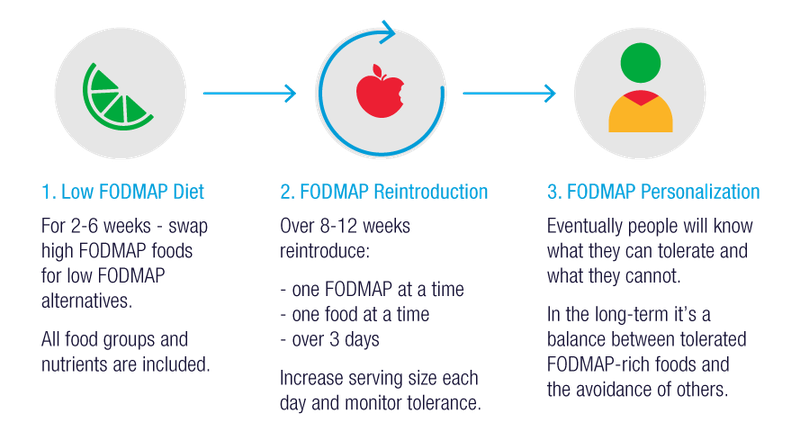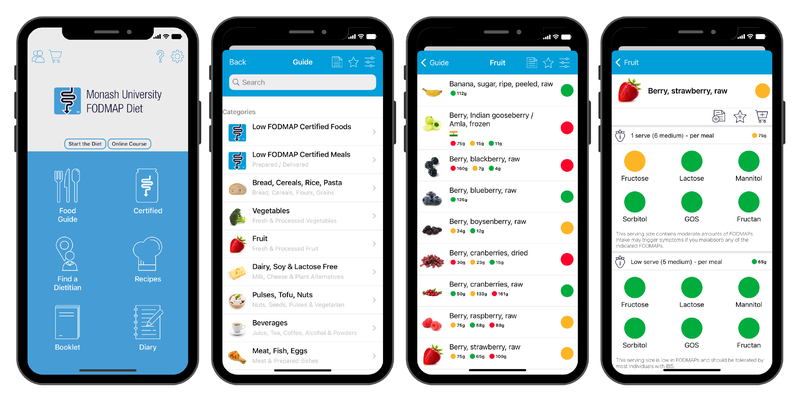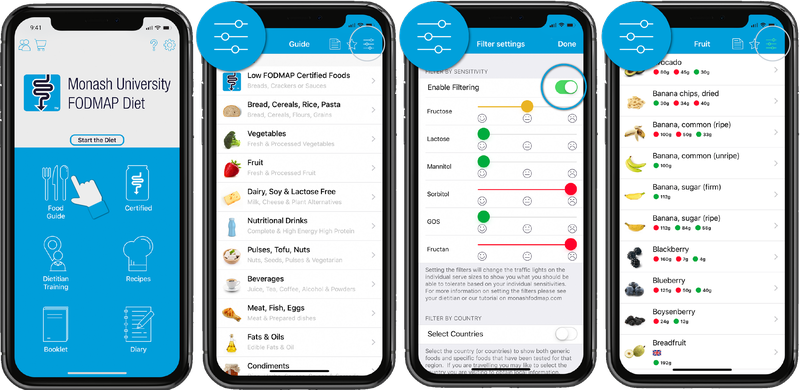What is the purpose of a FODMAP diet?
A FODMAP diet is a 3 step diet used to help manage the symptoms of medically diagnosed irritable bowel syndrome (IBS). IBS is a very common gut problem with symptoms including abdominal (tummy) pain, bloating, wind (farting) and changes in bowel habit (diarrhea, constipation or both).
The aims of the diet are to:
- Learn which foods and FODMAPs you tolerate, and which trigger your IBS symptoms. Understanding this will help you to follow a less restrictive, more nutritionally balanced diet for the long term that only restricts foods that trigger your IBS symptoms.
- Assess whether your IBS symptoms are sensitive to FODMAPs. Not everyone with IBS will improve on a low FODMAP diet. So it is important to understand whether you are among the ¾ of IBS sufferers who improve on the diet, or the ¼ of IBS sufferers who do not experience symptom improvement on the diet and therefore need to consider other IBS therapies.
How to follow a FODMAP diet
A FODMAP diet is a 3 step diet.

Step 1
In Step 1, follow the Monash University Low FODMAP Diet™ by swapping high FODMAP foods in your diet for low FODMAP alternatives. For example, if you normally eat wheat-based toast with honey for breakfast, you could swap to sourdough spelt toast with jam. The Food Guide of the Monash FODMAP App is very useful in this step of the diet. Use the simple traffic light system to identify high (red) and moderate (amber) FODMAP foods that you will swap for low (green) FODMAP alternatives. Follow the Step 1 diet for 2-6 weeks. If your symptoms improved after 2-6 weeks on the Step 1 diet, it is time to move onto the Step 2 diet. If they did not improve, it might be that your IBS symptoms are not sensitive to FODMAPs and you need to consider other therapies, such as stress reduction, gut directed hypnotherapy, over-the-counter medications such as laxatives, fibre supplements, or prescription medications.

Step 2
In Step 2, you continue your low FODMAP diet (as per step 1). However, you will complete a series of ‘FODMAP challenges’ to identify which FODMAPs you tolerate and which trigger symptoms. FODMAP ‘challenges’ involve eating a food rich in only 1 FODMAP group daily for 3 days and monitoring symptoms. The diary section of the Monash FODMAP App is very useful in this step, as it lists foods that you can use for each FODMAP challenge. These foods are recommended because they contain large amounts of one FODMAP type. For instance, milk is high in lactose, but does not contain any other FODMAPs. Very common foods (such as apple, pear, certain legumes and wheat products) that are high in two FODMAP types are also included as optional challenges in the diary (see below). After each 3-day challenge, record how well you tolerated the FODMAP(s). You can do this using a paper diary, or the Diary in the Monash FODMAP App. The in-app Diary allows you to record challenge foods eaten, IBS symptom type and severity, bowel habit and stress levels.

Step 3
In Step 3, the aim is to relax dietary restrictions as much as possible, expand the variety of foods included in your diet and establish a ‘personalized FODMAP diet’ for the long-term. In this step well tolerated foods and FODMAPs are reintroduced to your diet, while poorly tolerated foods and FODMAPs are restricted, but only to a level that provides symptom relief. We recommend that you repeat challenges of poorly tolerated foods and FODMAPs over time to see whether your tolerance changes. You can also use the Filter function in the Monash FODMAP App to personalize your app experience during Step 3 of the diet.

Where to get help
A FODMAP diet should be followed under the guidance of a dietitian who has specialty skills in managing IBS and using a FODMAP diet. Monash FODMAP Trained Dietitians can be found on our App and website, via the Monash FODMAP Dietitian Directory. All dietitians listed in our Dietitian Directory have completed and passed our 30 hour online course on FODMAPs and IBS.
For dietitians - learn more about our Monash FODMAP online training
